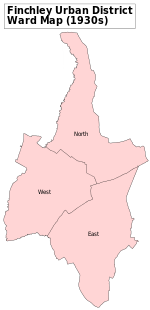Church End, Finchley
| Church End | |
| Ballards Lane |
|
 Church End |
|
| Population | 15,715 (2011 Census. Finchley Church End Ward)[1] |
|---|---|
| OS grid reference | TQ255905 |
| – Charing Cross | 7 mi (11.3 km) SSE |
| London borough | Barnet |
| Ceremonial county | Greater London |
| Region | London |
| Country | England |
| Sovereign state | United Kingdom |
| Post town | LONDON |
| Postcode district | N3 |
| Dialling code | 020 |
| Police | Metropolitan |
| Fire | London |
| Ambulance | London |
| EU Parliament | London |
| UK Parliament | Finchley and Golders Green |
| London Assembly | Barnet and Camden |
Coordinates: 51°36′08″N 0°11′34″W / 51.6021°N 0.1927°W
Church End (often known as "Finchley Central") is a locality within Finchley in the London Borough of Barnet in London, England. It is the location of Finchley Central tube station. Church End is an old village and now a suburban development situated 7 miles (11 km) north-northwest of Charing Cross.
Toponymy
Church End was named in 1683. The name is formed from Middle English 'churche' and 'ende' and means 'district by the church'.[2] The name refers to the parish church of Finchley, St Mary. Finchley Church End is the name of a ward in Barnet.[3]
Geography


The main road runs on a south-north axis, and is called Regents Park Road (previously Ducksetters Lane) from the North Circular Road until it reaches the road bridge at Finchley Central tube station (Northern Line), where the name changes to Ballards Lane. Its heart is the ancient district around St Mary’s Church, where the imposing tower of Pardes House Primary School (formerly Christ’s College Finchley) is a landmark.
There is a public library in Hendon Lane, next to the church. Along Regents Park Road and Ballards Lane, close to the station, is a retail district with a Victorian and Edwardian shopping parade as well as a couple of pubs and modern shops including Sainsbury's and Tesco.
To the southeast along East End Road are two institutions of note: Avenue House, built in 1859 and home to the Finchley Society, and a Jewish cultural centre, the Sternberg Centre. Avenue House was the home of Henry 'Inky' Stephens (1841-1918), son of Dr Henry Stephens (1796-1864) who founded the Stephens Ink Company, the first producers of "Blue-Black Writing Fluid" in 1832.
A small museum - The Stephens Collection - open three afternoons a week and occasional Sundays commemorates this invention and the Stephens family, along with the history of writing materials including many photographs and artefacts.
'Inky' Stephens, a former local MP, left Avenue House to "the people of Finchley" on his death in 1918. The house and ten acres of fine landscaped gardens and parkland open to the public are now run by a local charitable trust. In February 2014 the estate was relaunched and rebranded, in conjunction with a Heritage Lottery Fund bid, as Stephens House and Gardens.
South, along Regents Park Road, is College Farm, the last farm in Finchley (entrance in Fitzalan Road), and a statue, referred to locally as "The Naked Lady", but more properly named La Délivrance. Victoria Park is the home of the Finchley Carnival, a large fun fair held every year in July, dating back to 1905.[4]
 |
West Finchley | North Finchley | Friern Barnet |  |
| Mill Hill | |
East Finchley | ||
| ||||
| | ||||
| Hendon | Temple Fortune | Hampstead Garden Suburb |
History
References
- ↑ "Barnet Ward population 2011". Neighbourhood Statistics. Office for National Statistics. Retrieved 19 October 2016.
- ↑ Mills, D. (2000). Oxford Dictionary of London Place Names. Oxford University Press. ISBN 978-0199566785.
- ↑
- ↑ Archived 7 April 2005 at the Wayback Machine.
